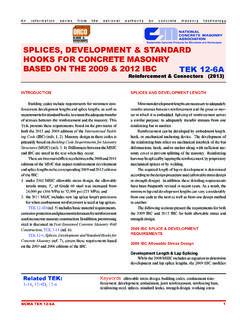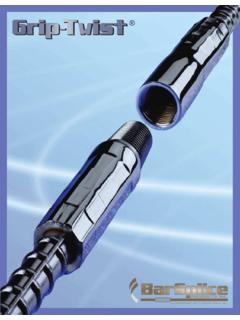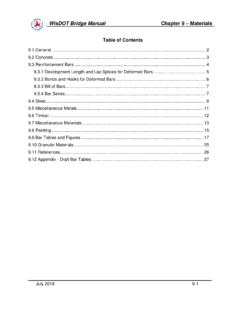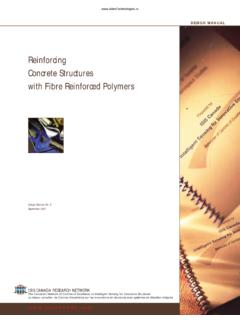Transcription of Significant changes from the 2011 to the 2014 …
1 March April 2016 | PCI Journal56 The American Concrete Institute (ACI) has pub-lished Building Code Requirements for Struc-tural Concrete (ACI 318-14) and Commentary (ACI 318R-14),1 and it has been adopted by the 2015 International Building Code (IBC).2 Thus, whenever the 2015 IBC is adopted by a local jurisdiction, as it will be by the state of California on January 1, 2017, ACI 318-14 will be law within that is fairly well known by now, ACI 318 has undergone a complete reorganization from its 2011 to its 2014 edi-tion. In view of the effort involved in the reorganization, the initial expectation was that the number of technical changes in ACI 318-14 would be minimal. However, it did not end up that way. ACI 318-14 does contain a number of Significant technical changes , some of the most important of which are found in chapter 18, Earthquake Resistant Structures. Organizational changes from ACI 318-113 to ACI 318-14 are discussed, followed by a chapter-by-chap-ter list of the Significant technical changes .
2 Throughout the paper, underlining is used to indicate text that was not in ACI 318-11 but has been added in ACI 318-14; strik-ing out has been used to indicate text that was included in ACI 318-11 but has been deleted from ACI 318-14. The 2014 edition of American Concrete Institute (ACI) s Building Code Requirements for Structural Concrete (ACI 318-14) and Commentary (ACI 318R-14) has undergone a complete reorga-nization from its 2011 edition. ACI 318-14 contains a number of Significant technical chang-es, with some of the most important in chapter 18, Earthquake Resistant Structures. changes from ACI 318-11 to ACI 318-14 are discussed in this paper. Significant changes from the 2011 to the 2014 edition of ACI 318 Satyendra K. Ghosh57 PCI Journal | March April 2016 Overall changesThere are some overall changes in the makeup of ACI 318-14 that should be noted. There are two new chap-ters: chapter 4, Structural System Requirements, and chapter 12, Diaphragms.
3 Appendix B of ACI 318-11, Alternative Provisions for Reinforced and Prestressed Concrete Flexural and Com-pression Members, and appendix C, Alternative Load and Strength Reduction Factors, have been A, Strut-and-Tie Models, is now chapter 23, and appendix D, Anchoring to Concrete, is chapter 17 in the reorganized document. No changes of any significance have been made in the provisions of chapter 23 or appen-dix other chapters have remained intact: chapter 20, now 27, Strength Evaluation of Existing Structures; chapter 21, now 18, Earthquake-Resistant Structures; and chapter 22, now 14, Structural Plain Concrete. There are Significant technical changes in chapter 18 and none in chapter 27 or 14. Chapter 1, General (previously Gen-eral Requirements ); chapter 2, Notation and Terminol-ogy (previously Notation and Definitions ), and chapter 3, Referenced Standards (previously Materials ) are in the same category in the sense that they have remained es-sentially the same entities but with changes in 16, Precast Concrete, and chapter 18, Pre-stressed Concrete, no longer exist as separate entities.
4 The provisions of those chapters are now spread over several of the new chapters. Chapter 19, Shells and Folded Plates, is no longer part of the reorganized document. ACI Committee 318, in col-laboration with ACI-ASCE Committee 334, Concrete Shell Design and Construction, has developed ACI ,8 whose contents match those of ACI 318-11 chapter 19. (The reader may wonder why this document was desig-nated ACI rather than ACI This is because it was initially planned that ACI 318-11 chapter 22 on plain concrete would become a separate standard, ACI The number was reserved for that purpose. It was later decided to place the contents of ACI 318-11 chapter 22 in ACI 318-14 chapter 14.)Table 1 shows a side-by-side comparison of the organiza-tion of ACI 318-11 and ACI 318-14. ACI 318-14 has no appendixes. It is likely that appendixes will be acquired in time because ACI 318 appendixes have served a useful purpose in the past by providing a home for material on its way into the standard (ACI 318-11 ap-pendixes A and D, for example) or material on its way out (ACI 318-11 appendixes B and C, for example).
5 Organizational changesOrganization of ACI 318-11 The organization of ACI 318-11 followed a framework that was started with ACI There have been eight edi-tions in between, in 1977, 1983, 1989, 1995, 1999, 2002, 2005, and 2008, with the framework remaining essentially 318-11, following initial chapters on materials and construction aspects, dealt with analysis and design and strength and serviceability requirements in two succeeding chapters. Next, there were three behavior-based chapters, one on flexure and axial loads, one on shear and torsion, and one on development and splices of reinforcement. The document then switched to member-based chapters: two-way slab systems, walls, and footings. Finally, there were chapters on precast concrete, composite concrete flexural members, prestressed concrete, shells and folded plate members, strength evaluation of existing structures, earthquake-resistant structures, and structural plain con-crete.
6 There were also four appendixes, including one on strut-and-tie models and one on anchoring to organization in ACI 318-14 While the ACI 318 cycle that produced ACI 318-055 and ACI 318-086 was still in full swing, it was decided after long deliberation within ACI, in the course of which exter-nal input was actively sought and considered, that ACI 318 should be reorganized as a member-based document. The idea was that within each chapter devoted to a particular member type, such as beam or column, the user would find all the requirements necessary to design that particular member type. Cary Kopczynski,7 an ACI 318 committee member, says, This will eliminate the need to flip through several chapters to comply with all of the necessary design requirements for a particular structural member, as was necessary with the old organization format. The code s new design can be compared to a cookbook: all the ingredients for baking a cake such as eggs, flour, sugar, oil along with the baking instructions are in one chapter, instead of individual chapters on eggs, flour, and sugar.
7 Toolbox chaptersOne challenge in converting to a member-based organiza-tion was determining where to place design information that applies to multiple member types, such as develop-ment-length requirements. To repeat essentially the same information in multiple chapters did not make sense be-cause that would make the ACI 318 standard much longer and more unwieldy, so the decision was made to house such information in toolbox chapters and to reference the information from the member-based April 2016 | PCI Journal58 Table 1. Reorganization of ACI 318-14 compared with ACI 318-11 ACI 318-11 ACI 318-14 CommentDescription of provisionsChapter and titleDescription of provisionsChapter and titleIntroductory1 - General RequirementsIntroductory1 - General2 - Notation and Definitions2 - Notation and Terminology3 - Materials3 - Referenced StandardsMaterials/ construction4 - Durability RequirementsOther4 - Structural System RequirementsNew5 - Concrete Quality, Mixing, and Placing5 - Loads6 - Formwork, Embedded Pipes.
8 And Con-struction Joints6 - Structural Analysis7 - Details of ReinforcementMember-based7 - One-Way SlabsOther8 - Analysis and Design General Consid-erations8 - Two-Way Slabs9 - Strength and Serviceability Require-ments9 - BeamsBehavior-based10 - Flexure and Axial Loads10 - Columns11 - Shear and Torsion11 - Walls12 - Development and Splices of Rein-forcement12 - DiaphragmsNewMember-based13 - Two-Way Slab Systems13 - Foundation14 - WallsOther14 - Plain ConcreteIntact15 - FootingsConnections15 - Beam-Column and Slab-Column JointsOther16 - Precast Concrete16 - Connections between Members17 - Composite Concrete Flexural Members17 - Anchoring to ConcreteIntact18 - Prestressed ConcreteOther18 - Earthquake-Resistant StructuresIntact19 - Shells and Folded Plate MembersMaterials19 - Code Requirements for Thin Shells and CommentaryACI - Strength Evaluation of Existing Structures20 - Steel Reinforcement Properties, Dura-bility, and Embedments21 - Earthquake-Resistant StructuresToolbox21 - Strength Reduction Factors22 - Structural Plain Concrete22 - Sectional StrengthApp.
9 A - Strut-and-Tie Models23 - Strut-and-Tie ModelsIntactApp. B - Alternative Provisions for Rein-forced and Prestressed Concrete Flexural and Compression Members (discontinued)24 - Serviceability RequirementsApp. C - Alternative Load and Strength Reduction Factors (discontinued)25 - Reinforcement DetailsApp. D - Anchoring to ConcreteConstruction26 - Construction Documents and Inspec-tionOther27 - Strength Evaluation of Existing StructuresIntact59 PCI Journal | March April 2016seismic hooks at both ends. A closed tie shall not be made up of interlocking headed deformed definition for special seismic systems, a term used in chapters 18 and 19, has been added:special seismic systems Structural systems that use special moment frames, special structural walls, or 3: Referenced StandardsThe following referenced specifications have been added to section : ASTM A370-14, Standard Test Methods and Defini-tions for Mechanical Testing of Steel Products9 ASTM A1085-13, Standard Specification for Cold-Formed Welded Carbon Steel Hollow Structural Sec-tions (HSS)10 ASTM C173/C173M-14, Standard Test Method for Air Content of Freshly Mixed Concrete by the Volu-metric Method11 ASTM C1582/C1582M-11, Standard Specification for Admixtures to Inhibit Chloride-Induced Corrosion of Reinforcing Steel in Concrete12 The following referenced specifications have been deleted.
10 ASTM C109/C109M-08, Standard Test Method for Compressive Strength of Hydraulic Cement Mortars (Using 2-in. or [50-mm] Cube Specimens)13 ASTM C192/C192M-07, Standard Practice for Making and Curing Concrete Test Specimens in the Laboratory14 Several referenced standards and specifications have been updated, as always happens with every new edition of ACI 318. Note that the edition of every referenced standard is important. ACI 318 does not necessarily adopt new edi-tions of referenced standards unless they are vetted before the publication of each edition of the 4: Structural System RequirementsThis chapter has been added to ACI 318-14 to introduce structural system requirements. This chapter contains sections on materials, design loads, structural system and load paths, structural analysis, strength, serviceability, durability, sustainability, structural integrity, fire resistance, requirements for specific types of construction, construc-tion and inspection, and strength evaluation of existing structures.



